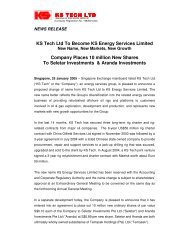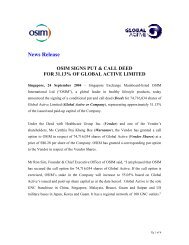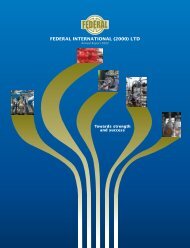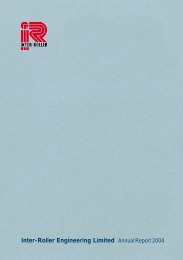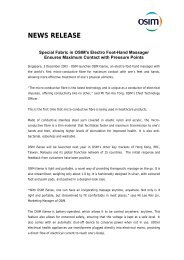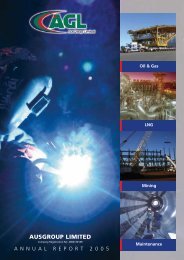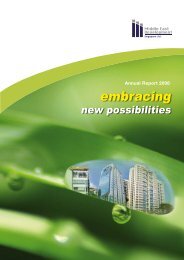FRONTLINE COVER FA 070606 CR2.indd
FRONTLINE COVER FA 070606 CR2.indd
FRONTLINE COVER FA 070606 CR2.indd
Create successful ePaper yourself
Turn your PDF publications into a flip-book with our unique Google optimized e-Paper software.
frontline technologies corporation ltd<br />
annual report 2006 57<br />
> notes to the financial statement<br />
for the year ended 31 march 2006<br />
2. Significant accounting policies (cont’d)<br />
(j) Intangible assets (cont’d)<br />
(iii) Research and development costs<br />
Research costs are expensed as incurred. Development expenditure incurred on an individual project is<br />
recognised as an asset to the extent that it is expected that such asset will generate future economic benefits.<br />
Following the initial recognition of the development expenditure, the cost model is applied requiring the asset<br />
to be carried at cost less any accumulated amortisation and accumulated impairment losses. Any expenditure<br />
recognised as an asset is amortised over the period of expected future sales from the related project.<br />
(iv)<br />
(v)<br />
(vi)<br />
Intellectual property<br />
Intellectual property relates to the tools and methodologies and know-how purchased from business<br />
acquisition. It is recognised at its fair value of the future net cash flows and amortised over the estimated<br />
useful life of up to 15 years (2005:10 years). During the current financial year, the Group changed the<br />
amortisation of its intellectual property from 10 years to 15 years to reflect a more accurate pattern of<br />
consumption of the economic benefits of the intangible asset. The change in estimated useful life has no<br />
material financial effect on the financial statements of the Group during the financial year.<br />
Client contracts<br />
Client contracts relate to existing contracts with third party customers, purchased from business acquisition, with<br />
a fixed stream of revenues. It is recognised at its fair value representing net cash flows to be derived during the<br />
existing contractual period and amortised over the remaining useful life of the contracts not exceeding 3 years.<br />
Software under development<br />
No amortisation is charged for software under development.<br />
(k)<br />
Impairment of non-financial assets<br />
At each balance sheet date, the Group and Company reviews the carrying amounts of its non-financial assets<br />
to determine whether there is any indication that those assets have suffered an impairment loss. If any such<br />
indication exists, the recoverable amount of the asset is estimated in order to determine the extent of the<br />
impairment loss, if any. Where it is not possible to estimate the recoverable amount of an individual asset, Group<br />
estimates the recoverable amount of the cash-generating unit to which the asset belongs.<br />
Recoverable amount is the higher of fair value less costs to sell and value in use. In assessing value in use, the<br />
estimated future cash flows are discounted to their present value using a pre-tax discount rate that reflects<br />
current market assessments of the time value of money and the risks specific to the asset.<br />
If the recoverable amount of an asset (or cash-generating unit) is estimated to be less than its carrying amount,<br />
the carrying amount of the asset (cash-generating unit) is reduced to its recoverable amount. An impairment loss<br />
is recognised immediately in the income statement, unless the relevant asset is carried at a revalued amount, in<br />
which case the impairment loss is treated as a revaluation decrease.<br />
Where an impairment loss subsequently reverses, the carrying amount of the asset (cash-generating unit) is<br />
increased to the revised estimate of its recoverable amount, but so that the increased carrying amount does<br />
not exceed the carrying amount that would have been determined had no impairment loss been recognised<br />
for the asset (cash-generating unit) in prior years. A reversal of an impairment loss is recognised immediately in<br />
the income statement unless the relevant asset is carried at a revalued amount, in which case the reversal of the<br />
impairment loss is treated as a revaluation increase.





